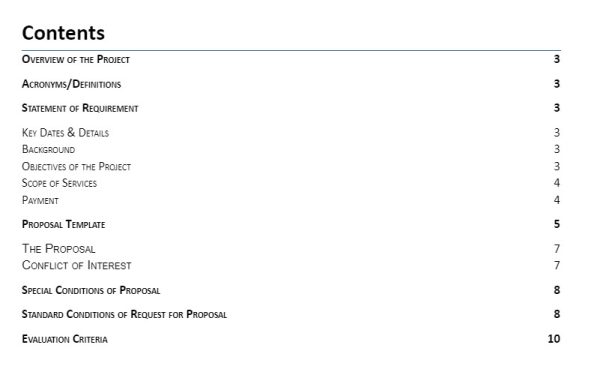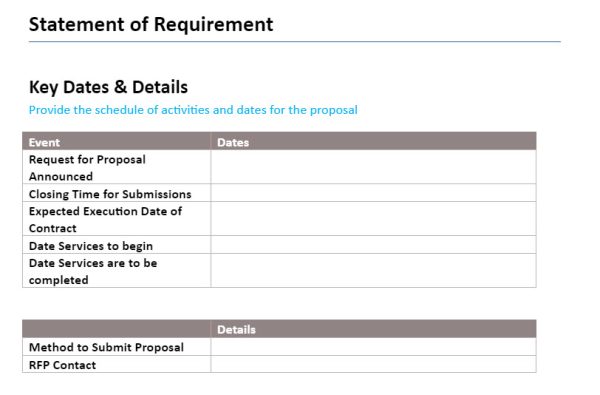Writing a Request for Proposal (RFP) template that’s compelling can be a game-changer for your business. Whether you’re a seasoned professional or a novice, having a well-structured and engaging RFP template can make all the difference in attracting the right vendors and ultimately landing your dream projects. But exactly what is an RFP? We’re sharing how to write a request for proposal, the components of an RFP, an RFP example, and an RFP template for download.
In this ultimate guide, we will also share crucial steps to write an RFP that will stand out from the competition. From understanding the key components to incorporating your brand voice, we will provide actionable tips to help you craft an RFP template that compels vendors to take notice.
Your RFP template needs compelling headlines and persuasive language to capture vendors’ attention and convey your company’s unique brand personality. Whether your brand voice is authoritative, friendly, or innovative, we will explore how to infuse it into an RFP template effortlessly.
So, if you’re ready to improve your RFP game and win those coveted projects, let’s explore the ultimate guide to crafting a solid and compelling RFP example and template.
What is a Request for Proposal (RFP)
A Request for Proposal (RFP) is a document that outlines the requirements and objectives for a particular project or service. It is then distributed to potential vendors or service providers. The RFP serves as a formal invitation for vendors to submit their proposals, detailing how they can meet the project’s requirements and deliver the desired outcomes.
An RFP typically includes information such as the project background, scope of work, desired deliverables, timeline, budget, and evaluation criteria. It provides a structured framework for vendors to understand what the client is looking for and enables them to submit comprehensive proposals that address the client’s needs.
The RFP process is widely used in various industries, including technology, construction, marketing, and consulting. It allows organizations to gather competitive bids, compare proposals, and select the vendor that offers the best value and aligns with their project goals. As you write an RFP, remember that it sets the foundation for a successful project and ensures that all stakeholders are on the same page from the start.
The importance of a well-crafted RFP template
Having a solid RFP template is essential for several reasons. It helps you clearly communicate your project requirements and expectations to potential vendors. By providing a comprehensive and detailed RFP, you ensure that vendors have all the necessary information to submit accurate and relevant proposals.
Your RFP template enables you to attract the right vendors and filter out those who may not be a good fit for your project. By clearly outlining your project’s objectives, desired outcomes, and evaluation criteria, you can ensure that only qualified vendors with the right expertise and capabilities submit proposals.
A well-designed RFP template sets you apart. It should use a professional tone that demonstrates your organization’s commitment to a transparent and fair selection process. It should also show potential vendors that you value their time and effort by providing them with a clear roadmap of what you expect from their proposals.
Using an RFP template can save you time and effort in the long run. By providing vendors with all the necessary information upfront, you minimize the back-and-forth communication and ensure that all proposals are aligned with your requirements. This streamlines the evaluation process and allows you to make a well-informed decision efficiently.
Here’s an RFP example – content to be included.
Understanding the target audience and objectives of the RFP
Before diving into writing an RFP template, it’s crucial to understand your target audience and the objectives of the RFP. Consider who will be reading the RFP and what their needs and expectations are. Are they potential vendors, stakeholders, or decision-makers? Understanding your audience will help you tailor your RFP template to their specific requirements.
Clearly define the objectives of the RFP. What are you trying to achieve through this RFP? Is it to find the best vendor for a specific project? Are you looking to gauge the market and gather information for future projects? Defining your objectives will help you structure the RFP template effectively.
Once you have a clear understanding of your target audience and objectives, you can write an RFP from scratch or by using a template. Remember to keep your audience in mind while crafting the language and tone of the template. Use language that resonates with your audience and reflects your brand voice.
Developing clear and concise project requirements and scope of work
One of the most critical components of an RFP template is the project requirements and scope of work. Vendors need clear and concise information about what you expect from them. Ambiguity can lead to confusion and may result in inaccurate proposals.
Start by outlining the project requirements in a logical and organized manner. Break down the project into specific tasks or deliverables, and clearly define the timeline and deadlines. Be as specific as possible to provide vendors with a clear understanding of the project’s scope and complexity.
Avoid using technical jargon or industry-specific terms that vendors may not be familiar with. Instead, use plain language and provide explanations where necessary. Remember, the goal is to ensure that vendors fully comprehend the project requirements and can submit accurate proposals.
Consider including examples or case studies to make the project requirements and scope of work even more effective. This can help vendors visualize the desired outcome and better understand your expectations. Providing relevant references or samples can also help vendors tailor their proposals to align with your vision.
RFP Example – Statement of Requirements
Including evaluation criteria and selection process in the RFP template
Transparency and clarity are essential when it comes to the evaluation criteria and selection process. Vendors need to know how their proposals will be evaluated and what factors will be considered in the selection process. Clearly define the evaluation criteria and weightage for each criterion to provide vendors with a fair understanding of the selection process.
Consider including both qualitative and quantitative evaluation criteria. Qualitative criteria may include factors such as experience, expertise, and approach, while quantitative criteria may involve pricing, timelines, and deliverables. By including a mix of criteria, you can holistically evaluate vendors and select the best fit for your project.
It’s also important to define the selection process. Will there be multiple rounds of evaluation? Will there be a presentation or interview stage? Clearly outline each step of the selection process and provide vendors with a timeline for each stage. This will help vendors plan their submissions accordingly and allow for a smooth and efficient evaluation process.
By including evaluation criteria and a transparent selection process, you build trust with vendors and demonstrate your commitment to fairness. This can attract high-quality proposals from vendors who understand the requirements and are confident in their ability to meet them.
Designing a professional and visually appealing RFP template
While the content of your RFP template is crucial, the design and visual appeal also play a significant role in capturing the attention of vendors. A well-designed RFP template not only looks professional but also enhances readability and comprehension. Here are some tips for designing a visually appealing RFP template:
- Use a consistent brand identity: Incorporate your company’s brand colors, logo, and typography to maintain brand consistency throughout the RFP template. This helps reinforce your brand identity and make your RFP template instantly recognizable.
- Organize information with headings and subheadings: Structure the content of your RFP template with clear and descriptive headings and subheadings. This will help vendors navigate through the document and locate specific sections quickly.
- Utilize white space: Avoid cluttering the RFP template with excessive text or graphics. Leave ample white space around the text to make it more visually appealing and easier to read. White space also helps draw attention to important information and key sections.
- Use visuals strategically: Incorporate relevant visuals, such as charts, graphs, or illustrations, to enhance the understanding of complex concepts or data. Visuals can also break up long sections of text and make the RFP template more engaging.
- Choose a readable font: Select a font that is easy to read and suits your brand’s aesthetic. Avoid using overly decorative or complex fonts that may hinder readability. Stick to a font size that is comfortable to read, generally between 10 and 12 points.
By following these design tips, you can create a request for proposal template that not only communicates effectively but also visually appeals to vendors. This well-designed RFP example and useable template show how paying attention to detail and professionalism makes vendors more likely to take your proposal seriously.
Download our RFP template or other project management templates here
6 Tips for distributing and managing RFP responses
Once you write an RFP that covers essential details using an RFP template (download our RFP example), the next step is to effectively distribute it to potential vendors who are prioritizing potential projects and managing the incoming responses. Here are some tips to streamline the distribution and management process:
- Identify potential vendors: Research and identify potential vendors who align with your project requirements. Reach out to them directly or publish the RFP on relevant platforms or industry-specific websites to attract vendors who may not be on your radar.
- Provide a clear submission deadline: Clearly communicate the deadline for submissions in the RFP template. This ensures that vendors have sufficient time to prepare their proposals and allows you to stick to your project timeline.
- Establish a centralized communication channel: Create a designated email address or online platform to receive and manage RFP responses. This helps keep all communication in one place and makes it easier to track and evaluate proposals.
- Acknowledge receipt of proposals: Once vendors’ proposals are received, send an acknowledgment email. This not only confirms receipt but also provides an opportunity to address any potential submission issues or queries.
- Implement a structured evaluation process: Develop a structured evaluation process to assess the received proposals objectively. Consider involving a cross-functional team to ensure a comprehensive evaluation and minimize bias.
- Provide feedback to vendors: If possible, provide feedback to vendors who were not selected. Constructive feedback can help vendors improve their proposals and strengthen their future submissions. This also fosters positive relationships with vendors and encourages them to participate in future opportunities.
By following these tips, you can streamline the distribution and management of RFP responses, making the entire process more efficient and effective. Effective communication and clear guidelines will result in high-quality proposals and a smoother selection process.
Writing a request for proposal template is a crucial step in attracting the right vendors and securing your dream projects. By understanding your target audience, developing clear project requirements, incorporating evaluation criteria and a transparent selection process, designing a visually appealing template like our RFP example, and effectively managing requests for proposal responses, you can create an RFP template that stands out from the competition.
Remember, a strong RFP template not only captures the attention of vendors but also reflects your brand voice and personality. Infuse your unique brand identity into the template to create a lasting impression on vendors and differentiate yourself from competitors.
You now have the ultimate guide to writing an RFP that’s compelling. Follow our example of what should be included and either create your own template or use our easy-to-use RFP template. Elevate your RFP game, attract top-tier vendors, and secure those coveted projects that will take your business to new heights.




